Heart of Atlanta Motel, Inc. v. United States, 379 U.S. 241 (1964), was a landmark decision of the Supreme Court of the United States holding that the Commerce Clause gave the U.S. Congress power to force private businesses to abide by Title II of the Civil Rights Act of 1964, which prohibits discrimination in public accommodations.
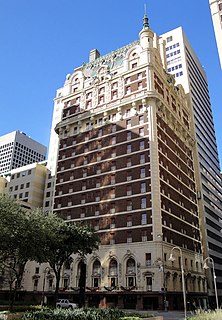
Hotel Adolphus is an upscale hotel and Dallas Landmark in the Main Street District of Downtown Dallas Dallas, Texas. It was for several years the tallest building in the state. Today, the hotel is part of Marriott Hotel's Autograph Collection.

The National Civil Rights Museum is a complex of museums and historic buildings in Memphis, Tennessee; its exhibits trace the history of the civil rights movement in the United States from the 17th century to the present. The museum is built around the former Lorraine Motel, which was the site of the assassination of Martin Luther King Jr. in 1968; King died at St. Joseph's Hospital. Two other buildings and their adjacent property, also connected with the King assassination, have been acquired as part of the museum complex.
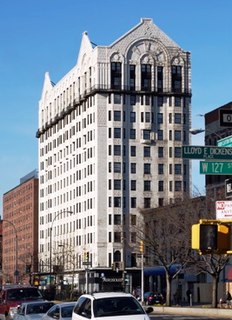
The Hotel Theresa is located at 2082-96 Adam Clayton Powell Jr. Boulevard between West 124th and 125th Streets in the Harlem neighborhood of Manhattan, New York City. In the mid-20th century, it was a vibrant center of African American life in the area and the city.

The Driskill, a Romanesque-style building completed in 1886, is the oldest operating hotel in Austin, Texas, United States, and one of the best-known hotels in Texas generally. The Driskill was conceived and built by Col. Jesse Driskill, a cattleman who spent his fortune constructing "the finest hotel south of St. Louis".
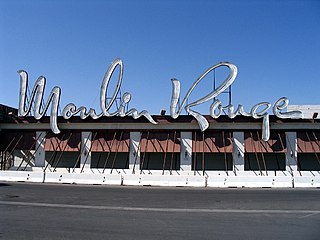
The Moulin Rouge Hotel was a hotel and casino located in the West Las Vegas neighborhood of Las Vegas, Nevada, that was listed on the United States National Register of Historic Places in 1992. Although its peak operation lasted only six months in the second half of 1955, it was the first desegregated hotel casino and was popular with many of the Black entertainers of the time, who would entertain at the other hotels and casinos and stay at the Moulin Rouge.

Avondale is a neighborhood in Cincinnati, Ohio. It is home to the Cincinnati Zoo and Botanical Garden. The population was 12,466 at the 2010 census.
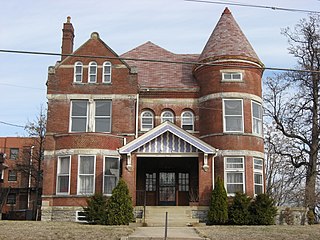
The C.H. Burroughs House is a historic former house in Cincinnati, Ohio, United States. Constructed at the end of the nineteenth century by one of the city's most prominent architects, the house has been converted into a social club, but it retains enough of its integrity to qualify for designation as a historic site.

The Cincinnatian Hotel is a registered historic building in Downtown Cincinnati, Ohio, listed in the National Register on March 3, 1980. It is a member of the Historic Hotels of America, the official program of the National Trust for Historic Preservation. Since 2018, the hotel has been managed by Hilton Worldwide and is part of its upscale Curio Collection brand.

Walnut Hills United Presbyterian Church is a historic church tower in the Walnut Hills neighborhood of Cincinnati, Ohio, United States. The last remnant of a landmark church building, it was designed by a leading Cincinnati architect and built in the 1880s. Although named a historic site a century after its construction, the building was mostly destroyed after extensive neglect caused restoration to become prohibitively expensive.

The Harlem YMCA is located at 180 West 135th Street between Lenox Avenue and Adam Clayton Powell Jr. Boulevard in the Harlem neighborhood of Manhattan, New York City. Built in 1931-32, the red-brown brick building with neo-Georgian details was designed by the Architectural Bureau of the National Council of the YMCA, with James C. Mackenzie Jr. as the architect in charge. It replaced the building from 1919 across the street. Inside the building is a mural by Aaron Douglas titled "Evolution of Negro Dance." The building was declared a National Historic Landmark in 1976, and was designated a New York City Landmark in 1998.
The United American Cemetery is the oldest African-American cemetery in Ohio, located on Duck Creek Road in Cincinnati, Ohio and founded in 1844 by the United Colored American Association. Among those interred at the cemetery who are notable are Horace Sudduth, an early twentieth century real estate speculator and owner of the Manse Hotel in Walnut Hills, and John Isom Gaines, a black educator.

Victor Hugo Green was an American postal employee and travel writer from Harlem, New York City, best known for developing and writing what became known as The Green Book, a travel guide for African Americans in the United States. During the time the book was published, choices of lodging, restaurants and even gas stations were limited for black people in many places, both in the South and outside it. It was first published as The Negro Motorist Green Book and later as The Negro Travelers' Green Book. The books were published from 1936 to 1966. Green reviewed hotels and restaurants that did business with African Americans during the time of Jim Crow laws and racial segregation in the United States. He printed 15,000 copies each year.
Marian Regelia Alexander Spencer was an American politician who served as Vice Mayor of the Cincinnati City Council in Cincinnati, Ohio. She was the first African American woman to be elected to the Council. The granddaughter of a former slave, she was active in the civil rights movement to desegregate schools and end discrimination, and became the first female president of the Cincinnati NAACP chapter. She also served on the University of Cincinnati board of trustees.

Canaan Baptist Church is a historic church at 824 Fifteenth Street North in Bessemer, Alabama. Built in 1961, it had a congregation active in the Civil Rights Movement of the 20th century and was added to the National Register of Historic Places in 2005.

The Negro Motorist Green Book was an annual guidebook for African-American roadtrippers. It was originated and published by African-American New York City mailman Victor Hugo Green from 1936 to 1966, during the era of Jim Crow laws, when open and often legally prescribed discrimination against African Americans especially and other non-whites was widespread. Although pervasive racial discrimination and poverty limited black car ownership, the emerging African-American middle class bought automobiles as soon as they could, but faced a variety of dangers and inconveniences along the road, from refusal of food and lodging to arbitrary arrest. In response, Green wrote his guide to services and places relatively friendly to African-Americans, eventually expanding its coverage from the New York area to much of North America, as well as founding a travel agency.
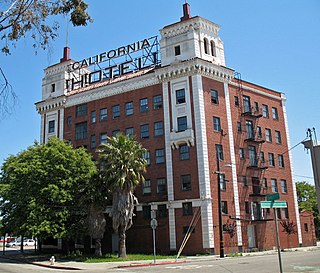
The California Hotel is a historic Oakland, California, hotel which opened in the early days of the Great Depression and became an important cultural center for the African-American community of San Francisco's East Bay during the 1940s, 50s and 60s. On June 30, 1988 the hotel was placed on the National Register of Historic Places.
Willa Mae Sudduth (1925-2015) was one of the founders of the Coalition of Labor Union Women. She was involved in many social justice causes, issues, and concerns most of her adult life. She was an African-American woman and the mother of six children.

Jennie Davis Porter was an American educator. She was the first African-American to receive a PhD from the University of Cincinnati and became the first black female principal of a public school in Cincinnati. In 1989, she was posthumously inducted into the Ohio Women's Hall of Fame.
















